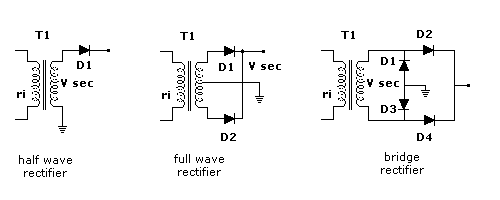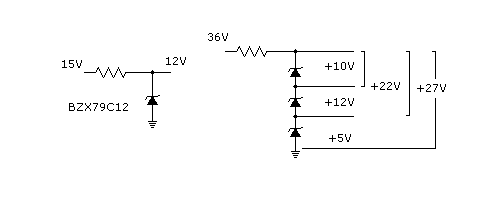| |
MODULE V - FUNDAMENTALS OF ELECTRONICS
DIODES
What Are Diodes?
Diodes are semiconductor devices which might be described as passing current in one direction only. The latter part of that statement applies equally to vacuum tube diodes. Diodes however are far more versatile devices than that. They are extremely versatile in fact. It might pay you to review the topic of Electron theory and atoms
Diodes can be used as voltage regulators, tuning devices in rf tuned circuits, frequency multiplying devices in rf circuits, mixing devices in rf circuits, switching applications or can be used to make logic decisions in digital circuits. There are also diodes which emit "light", of course these are known as light-emitting-diodes or LED's. As we say diodes are extremely versatile.
Schematic symbols for Diodes
A few schematic symbols for diodes are:

Figure 1 - schematic symbols for diodes
Types of Diodes
The first diode in figure 1 is a semiconductor diode which could be a small signal diode of the 1N914 type commonly used in switching applications, a rectifying diode of the 1N4004 (400V 1A) type or even one of the high power, high current stud mounting types. You will notice the straight bar end has the letter "k", this denotes the "cathode" while the "a" denotes anode. Current can only flow from anode to cathode and not in the reverse direction, hence the "arrow" appearance. This is one very important property of diodes.
The second of the diodes is a zener diode which are fairly popular for the voltage regulation of low current power supplies. Whilst it is possible to obtain high current zener diodes, most regulation today is done electronically with the use of dedicated integrated circuits and pass transistors.
The next of the diodes in the schematic is a varactor or tuning diode. Depicted here is actually two varactor diodes mounted back to back with the DC control voltage applied at the common junction of the cathodes. These cathodes have the double bar appearance of capacitors to indicate a varactor diode. When a DC control voltage is applied to the common junction of the cathodes, the capacitance exhibited by the diodes (all diodes and transistors exhibit some degree of capacitance) will vary in accordance with the applied voltage. A typical example of a varactor diode would be the Philips BB204G tuning diodes of which there are two enscapsulated in a TO-92 transistor package. At a reverse voltage Vr (cathode to anode) of 20V each diode has a capacitance of about 16 pF and at Vr of 3V this capacitance has altered to about 36 pF. Being low cost diodes, tuning diodes have virtually replaced air variable capacitors in radio applications today.
The next diode is the simplest form of vacuum tube or valve. It simply has the old cathode and anode. These terms were passed on to modern solid state devices. Vacuum tube diodes are mainly only of interest to restorers and tube enthusiasts.
The last diode depicted is of course a light emitting diode or LED. A led actually doesn't emit as much light as it first appears, a single LED has a plastic lens installed over it and this concentrates the amount of light. Seven LED's can be arranged in a bar fashion called a seven segment LED display and when decoded properly can display the numbers 0 - 9 as well as the letters A to F.
Rectifying Diodes
The principal early application of diodes was in rectifying 50 / 60 Hz AC mains to raw DC which was later smoothed by choke transformers and / or capacitors. This procedure is still carried out today and a number of rectifying schemes for diodes have evolved, half wave, full wave and bridge rectifiers.

Figure 2 - rectifying diodes
As examples in these applications the half wave rectifier passes only the positive half of successive cycles to the output filter through D1. During the negative part of the cycle D1 does not conduct and no current flows to the load. In the full wave application it essentially is two half wave rectifiers combined and because the transformer secondary is centre tapped, D1 conducts on the positive half of the cycle while D2 conducts on the negative part of the cycle. Both add together. This is more efficient. The full wave bridge rectifier operates essentially the same as the full wave rectifier but does not require a cetre tapped transformer. Further discussion may be seen on the topic power supplies.
A further application of rectifying diodes is in the conversion or detection of rf modulated signals to audio frequencies. Typical examples are am modulated signals being detected and early detection schemes for fm also used diodes for detecting modulation.
Voltage Regulating Diodes
For relatively light current loads zener diodes are a cheap solution to voltage regulation. Zener diodes work on the principle of essentially a constant voltage drop at a predetermined voltage (determined during manufacture). An example is a Philips BZX79C12 type with a regulation range between 11.4V and 12.7V but typically 12V and a total power dissipation of 500 mW in a DO-35 package. The dissipation can be extended by using a series pass transistor, see power supplies. Notice in figure 3 there is a resistor to miminmise current drawn but mainly as an aid to dropping the supply voltage and reducing the burden on the zener diodes.

Figure 3 - zener voltage regulation diodes
In the second schematic of figure 3 we have three zener diodes in series providing voltages of 5V, 10V, 12V, 22V and 27V all from a 36V supply. This configuration is not necessarily recommended especially when the current being drawn is seriously mismatched between voltages. It is presented purely out of interest.
More on Diodes>>>
|